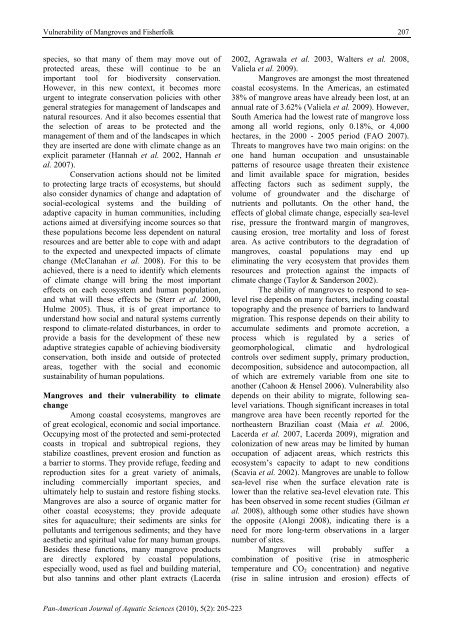Download full issue - PanamJAS
Download full issue - PanamJAS
Download full issue - PanamJAS
- No tags were found...
Create successful ePaper yourself
Turn your PDF publications into a flip-book with our unique Google optimized e-Paper software.
Vulnerability of Mangroves and Fisherfolk207species, so that many of them may move out ofprotected areas, these will continue to be animportant tool for biodiversity conservation.However, in this new context, it becomes moreurgent to integrate conservation policies with othergeneral strategies for management of landscapes andnatural resources. And it also becomes essential thatthe selection of areas to be protected and themanagement of them and of the landscapes in whichthey are inserted are done with climate change as anexplicit parameter (Hannah et al. 2002, Hannah etal. 2007).Conservation actions should not be limitedto protecting large tracts of ecosystems, but shouldalso consider dynamics of change and adaptation ofsocial-ecological systems and the building ofadaptive capacity in human communities, includingactions aimed at diversifying income sources so thatthese populations become less dependent on naturalresources and are better able to cope with and adaptto the expected and unexpected impacts of climatechange (McClanahan et al. 2008). For this to beachieved, there is a need to identify which elementsof climate change will bring the most importanteffects on each ecosystem and human population,and what will these effects be (Sterr et al. 2000,Hulme 2005). Thus, it is of great importance tounderstand how social and natural systems currentlyrespond to climate-related disturbances, in order toprovide a basis for the development of these newadaptive strategies capable of achieving biodiversityconservation, both inside and outside of protectedareas, together with the social and economicsustainability of human populations.Mangroves and their vulnerability to climatechangeAmong coastal ecosystems, mangroves areof great ecological, economic and social importance.Occupying most of the protected and semi-protectedcoasts in tropical and subtropical regions, theystabilize coastlines, prevent erosion and function asa barrier to storms. They provide refuge, feeding andreproduction sites for a great variety of animals,including commercially important species, andultimately help to sustain and restore fishing stocks.Mangroves are also a source of organic matter forother coastal ecosystems; they provide adequatesites for aquaculture; their sediments are sinks forpollutants and terrigenous sediments; and they haveaesthetic and spiritual value for many human groups.Besides these functions, many mangrove productsare directly explored by coastal populations,especially wood, used as fuel and building material,but also tannins and other plant extracts (Lacerda2002, Agrawala et al. 2003, Walters et al. 2008,Valiela et al. 2009).Mangroves are amongst the most threatenedcoastal ecosystems. In the Americas, an estimated38% of mangrove areas have already been lost, at anannual rate of 3.62% (Valiela et al. 2009). However,South America had the lowest rate of mangrove lossamong all world regions, only 0.18%, or 4,000hectares, in the 2000 - 2005 period (FAO 2007).Threats to mangroves have two main origins: on theone hand human occupation and unsustainablepatterns of resource usage threaten their existenceand limit available space for migration, besidesaffecting factors such as sediment supply, thevolume of groundwater and the discharge ofnutrients and pollutants. On the other hand, theeffects of global climate change, especially sea-levelrise, pressure the frontward margin of mangroves,causing erosion, tree mortality and loss of forestarea. As active contributors to the degradation ofmangroves, coastal populations may end upeliminating the very ecosystem that provides themresources and protection against the impacts ofclimate change (Taylor & Sanderson 2002).The ability of mangroves to respond to sealevelrise depends on many factors, including coastaltopography and the presence of barriers to landwardmigration. This response depends on their ability toaccumulate sediments and promote accretion, aprocess which is regulated by a series ofgeomorphological, climatic and hydrologicalcontrols over sediment supply, primary production,decomposition, subsidence and autocompaction, allof which are extremely variable from one site toanother (Cahoon & Hensel 2006). Vulnerability alsodepends on their ability to migrate, following sealevelvariations. Though significant increases in totalmangrove area have been recently reported for thenortheastern Brazilian coast (Maia et al. 2006,Lacerda et al. 2007, Lacerda 2009), migration andcolonization of new areas may be limited by humanoccupation of adjacent areas, which restricts thisecosystem’s capacity to adapt to new conditions(Scavia et al. 2002). Mangroves are unable to followsea-level rise when the surface elevation rate islower than the relative sea-level elevation rate. Thishas been observed in some recent studies (Gilman etal. 2008), although some other studies have shownthe opposite (Alongi 2008), indicating there is aneed for more long-term observations in a largernumber of sites.Mangroves will probably suffer acombination of positive (rise in atmospherictemperature and CO 2 concentration) and negative(rise in saline intrusion and erosion) effects ofPan-American Journal of Aquatic Sciences (2010), 5(2): 205-223
















